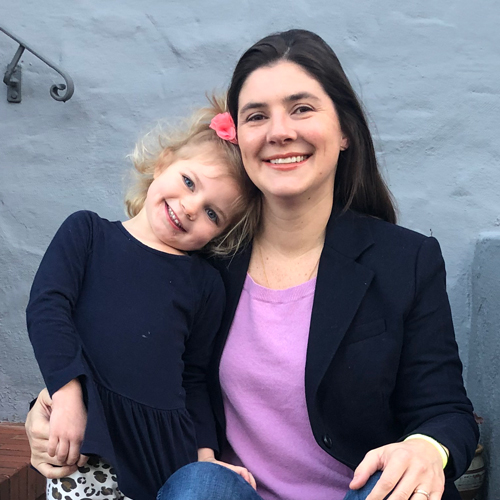Composting with a FoodCycler
Last week, I got the opportunity to try out Vitamix’s new machine called the FoodCycler FC-50. I bet you’re wondering what a FoodCycler is, right? Not unique to the Vitamix brand, it’s a countertop sized machine that heats and dries out your food scraps, then grinds and cools it back down all in one contained process. You end up with dehydrated food matter that can be combined with the native soil in your yard to enrich it. Vitamix reached out to me to see if I wanted to test it out when it was released August 2020. And yes, yes I very much wanted to test this out!!
I live in San Francisco, where participating in curbside compost pick up has been the norm for over a decade. SF started it’s composting program in 1996 but passed the law to make it mandatory by all residents in 2009. It’s going really well. We simply have 3 bins and separate items out, like most of the rest of the country does for trash and recycling. Commercial composting is a little bit different than backyard DIY. We can add meat, bones, cooking oils, corks, paper plates and take out boxes, yard trimmings, “compostable plastics,” and even hair from all of those Covid-Cuts we’re doing at home in 2020.
When talking about reducing food waste, the issue of composting or not comes up quite often. Is composting better than putting food scraps in the landfill?
Yes, but only to an extent.
The good news first.
- Putting organic matter into a compost pile or facility greatly reduces the amount of methane and carbon dioxide emitted from those items.
- It can reduce the amount of chemicals needed to break things down.
- Compost provides some degree of carbon sequestration, aka holding CO2 in the ground rather than releasing back into the atmosphere, which is incredibly important to mitigate the effects of global warming.
But there’s some bad news.
- Just because you compost doesn’t give you a license to waste food!
- Any food item that has landed on your plate required other resources to get there. Water, space on the land, refrigeration, water, gas, human labor, water. When you waste edible food, you’re also wasting those resources and composting does not stop that.
- (oh, did I repeat water a few times? 70% of the world’s available freshwater is used in agriculture. This isn’t a resource that we can live without or increase. Our current rates of use and waste will not support the global population in 20 years. This fact is reasons enough to care about how much food you waste and take preventative action.)
Back to compost and the FoodCycler, what should you do? It is better to compost than to put scraps in the landfill. If you can participate in a city run curbside pick up program, you are lucky and should absolutely take advantage of that and evangelize how amazing it is to your friends and neighbors so they get traction! This is by far the easiest option and I’d love to see it become as widespread as recycling pick up.
If you have space in your backyard to try a compost heap, and are willing to manage it then kudos to you! There are great resources online and cool easy stir bins or other gadgets to help. You will get high quality compost and it will easily take care of all of your family’s back-yard compostable food waste (you can’t compost meat, among other things, in a backyard because you’ll get rats).
If you don’t have either of those options you might consider using a food-cycler. The Vitamix FoodCycler FC-50 is compact and sleek looking, it reminded me of one of those countertop bread makers everyone was all about in the mid 90s. The first batch of compost I ran was filled to the max line with crusts brand, banana peels, lemon rinds, slimy spinach, carrot ends, a few crackers and cereal bits, and a small amount of stale rice. It processed for about 7 hours and turned into a fairly fine, quite dry pile of…well, basically dirt, but with some visible and identifiable dried vegetable threads. The overall volume was reduced by a shocking amount – about 7 cups of food scraps to 1.5 cups of dried food.
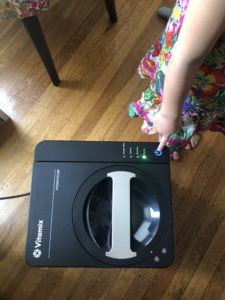
When Vitamix first told me about the machine, I had a couple of big misconceptions that seem a little ridiculous in hindsight. I definitely did not imagine that it would take 4-8 hours to process. I guess I was thinking more like 1 hour; like a dishwasher cycle. I also thought it would look like “real dirt” afterwards. I honestly was expecting something akin to bagged potting soil and was taken aback by the dried vegetables in the final mix.
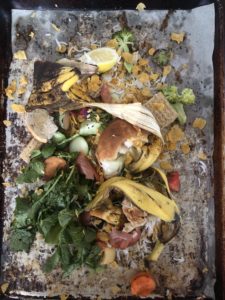
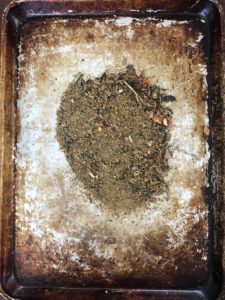
Before After
The instructions however, say to mix the dried and ground product into your native soil at a rate of 1 part dried scraps to 11 parts soil. Then you ideally let it be for 1-4 weeks to enrich the soil and you can plant or garden. That’s potent stuff! You can cover your garden in just a few batches.
The second batch I did was more of an experiment. I added more liquid items – a half cup of moldy pizza sauce, some apple cores, a scoop of hummus, celery ends, broccoli ends, and some onion peels. This batch came out looking like pulled pork, but dry! Completely different in texture. Either way, I folded it into my dirt and it’s currently enriching the area where I hope to grow some grass. The final texture doesn’t make any difference at all and once mixed with the native dirt, you can’t even see it.
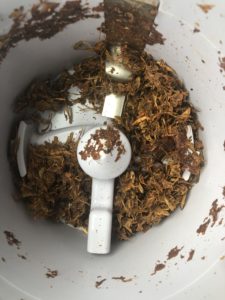
Batch 2
Regarding the time to process, it doesn’t matter. The machine is so quiet, you can’t hear it the next room over and they were so smart to build in an automatic shut off. The second time I ran it, I just turned it on when we went to sleep and in the morning it was cool and ready; the machine completely off. It is also, as advertised, entirely without a scent. There are carbon filters in the back and you can feel a bit of heat coming out but my whole family tried really quite hard to detect any smell whatsoever and there was none. You could run it with a dinner party in the next room without concern!
I haven’t used other brand’s food cyclers for comparison, but the Vitamix is what I expect from the trusted brand – sturdy, without excess buttons and breakable gadgets, it looks sleek, and it did its job well. My other favorite feature is that the inner bucket where you place the scraps lifts out and comes with a heavy lid that has a carbon filter on it. You can sit the entire thing on your counter to collect food scraps while waiting to fill the bucket. This is so smart! Now you can take your time to fill it up, it doesn’t smell because of the heavy bucket and fitted carbon filter lid, it looks ok on the counter, and you don’t have to be in the business of transferring food scraps to run the machine.
The question remains whether or not you need one. I got mine for free (thank you Vitamix!!!) and honestly, I’m super excited about it. But, I’m a chef, a food waste geek, and I have a yard with plenty of dirt that needs enriching. It does cost about $400 and only does this one thing. My family filled the bucket twice in less than a week and we’re only 4 people AND I’m hyper aware of not wasting food. A family less concerned with waste would either be running this machine constantly or only processing a fraction of their scraps. A family without a yard could put the dried end product in the trash and it would be better for the landfill, but, will you do that? I’m skeptical that anyone without a stake in the quality of dirt somewhere would bother. If I’m wrong, I hope you write me because I’d love to hear about it!
Ultimately, I think you’d enjoy this if you have space to keep it, have a yard and dirt to enrich, care about the planet and want to take action, and don’t have easy to use curbside composting or a good backyard DIY system already set up. And if you can afford it.

